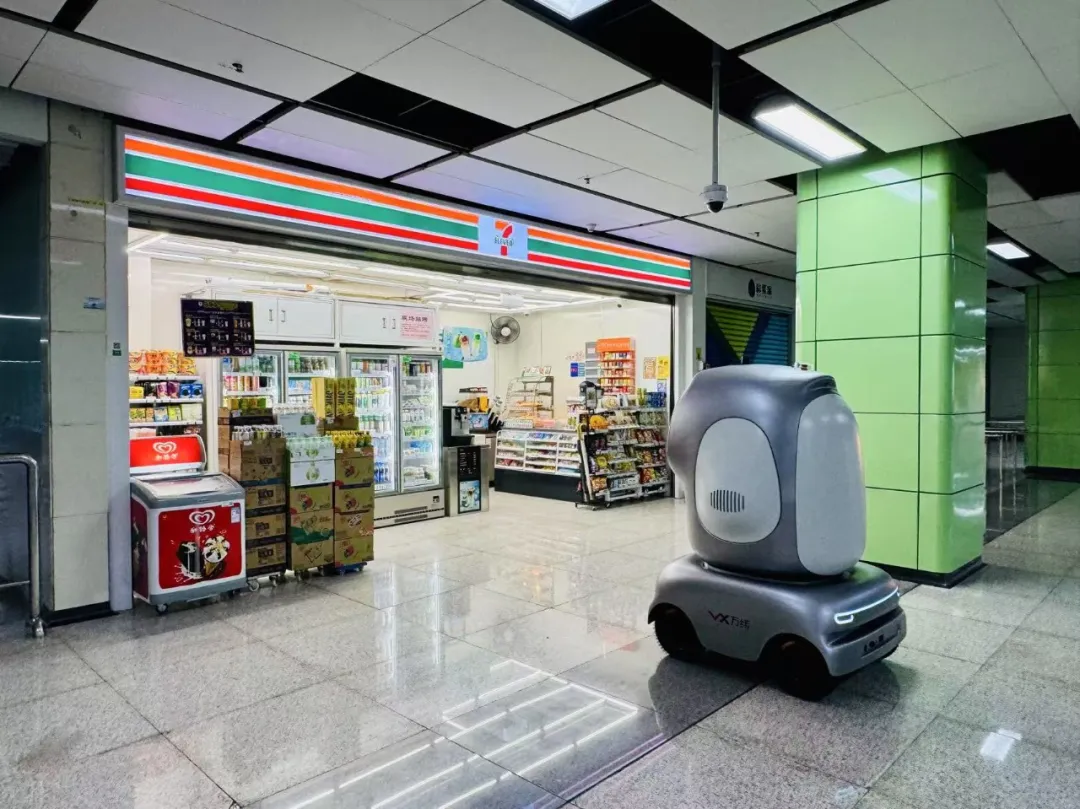By futureTEKnow | Editorial Team
Something strange is happening beneath the bustling cityscape of Shenzhen. Subway commuters have found themselves sharing train carriages with a fleet of penguin-shaped delivery robots—the latest sign that urban logistics are about to get a futuristic glow-up.
“In the past, delivery workers had to park above ground, unload goods, and push them into subway stations. Now, with robots, it’s much easier and more convenient,”
-explained a 7-Eleven manager involved in the pilot
More than forty autonomous robots recently made their debut along Shenzhen’s sprawling Metro Line 2, gliding from station to station to restock over 100 7-Eleven stores located inside the city’s subway complex. These one-meter-tall machines, operated by VX Logistics—a subsidiary of Vanke, part-owned by Shenzhen Metro—feature LED-lit faces and an endearing, chubby silhouette, but don’t be fooled: beneath the cute exterior lies an advanced delivery system equipped for serious logistical challenges.

Forget delivery workers pushing trolleys through crowded entrances—these bots:
Navigate lifts, platform gaps, and train doors with the help of panoramic lidar and a custom-built chassis.
Board trains during off-peak hours, minimizing disruption to human passengers and making use of unused public transport capacity.
Follow AI-powered routes that factor in real-time order data, store locations, cargo types, and metro schedules.
Deliver items straight to convenience stores within subway stations, where staff collect them directly from the robot’s storage compartment.
Beneath the novelty lies a powerful solution to urban headaches:
Relieving street-level congestion by shifting middle-mile logistics underground.
Reducing labor costs and delivery delays for shops inside transportation hubs.
Operating sustainably by leveraging existing metro infrastructure and smart routing, trimming the environmental impact compared to traditional truck-based supply.
It’s more than just automation—it’s a glimpse at how cities might blend multimodal transportation, AI, and robotics to supercharge efficiency.
Shenzhen’s robot rollout forms part of a grander blueprint: the Embodied Intelligent Robot Action Plan, which aims to boost service and industrial robot deployment through 2027. With over 1,600 robotics companies calling the city home, Shenzhen is rapidly becoming an urban testbed for smart technology.
VX Logistics envisions this as just the beginning. Future versions may carry mixed payloads for different destinations, interlink with other transport modes, and turn subway networks into flexible “delivery arteries” for megacities nationwide.
Shenzhen’s penguin delivery robots are more than a quirky sight—they signal a shift where public transit doubles as the backbone for smart logistics. As others race to place robots on sidewalks, Shenzhen is already rolling them through subway tunnels, rewriting what’s possible beneath the city lights.
Penguin-shaped robots now deliver goods to 100+ 7-Eleven subway stores in Shenzhen.
Robots use autonomous navigation, panoramic lidar, and AI dispatching for real-time optimization.
The initiative addresses longstanding urban logistics challenges, easing congestion and streamlining supply to underground retail.
This is a major step forward for smart city logistics and the integration of robotics with everyday transit infrastructure.
No sales pitch. Just a look at how the subway beneath your feet might soon be buzzing with more than just trains—and how the next delivery you receive might roll in with a digital smile.

Bridgit Mendler’s Northwood Space is pioneering mass-produced ground stations, enabling scalable, high-speed connectivity for the new era of satellite networks and megaconstellations.

SpaceX aims to nearly double launches from Vandenberg in 2025, facing support from federal agencies but strong objections from the state and local communities.

Traditional Medicare will pilot AI-assisted prior authorization in 2026 across six states, focusing on high-risk outpatient services. Clinicians retain final say, but incentives and access concerns loom as CMS tests fraud reduction and “gold card” exemptions. Here’s what providers and patients should know.

OpenArt’s new “one-click story” compresses scripting, visuals, and edits into ready-to-post short videos—fueling viral growth and a fresh IP debate. We break down how it works, adoption signals, what’s next (multi-character, mobile), and practical guardrails creators and brands should follow to stay original and compliant.

OpenAI’s o3 swept the Kaggle AI chess tournament, defeating xAI’s Grok 4–0. The victory fueled the intense rivalry between Altman and Musk, reshaping AI benchmarks.

NASA and Google’s AI-powered Crew Medical Officer Digital Assistant enables autonomous diagnoses for astronauts on Mars missions, redefining remote healthcare for space and Earth.

Pinterest’s CEO confirms that fully agentic AI shopping is years away, as the platform invests in AI-powered tools to enhance discovery, inspiration, and personalized shopping experiences for millions.

Shopify’s new AI shopping tools are transforming e-commerce, letting agents and chatbots deliver smooth, personalized shopping and checkout experiences across platforms. Learn how these innovations reshape online retail.

Meta has acquired WaveForms AI, a startup pioneering emotion-detecting voice technology. Learn what this means for Meta’s AI voice ambitions and the future of AI audio.

Tracelight is revolutionizing financial modelling for finance professionals with AI-powered Excel tools that automate complex tasks, reduce errors, and unlock new analysis capabilities. Learn how this next-gen solution changes the future of spreadsheets.

China’s Lanyue lander completed its first major test, showcasing advanced engineering for safe, crewed moon landings before 2030. Explore how this milestone shapes the space race.

Microsoft rolls out GPT-5 across its Copilot suite, integrating smarter AI for enterprise and personal users. Discover new features, free access, and what sets this launch apart.
To provide the best experiences, we use technologies like cookies to store and/or access device information. Consenting to these technologies will allow us to process data such as browsing behavior or unique IDs on this site. Thanks for visiting futureTEKnow.